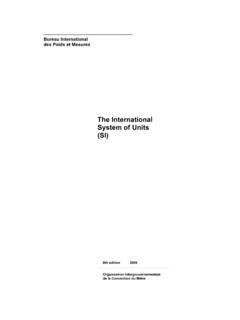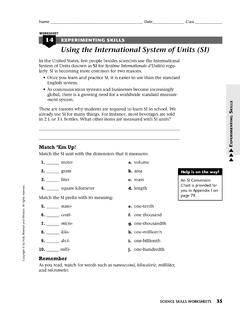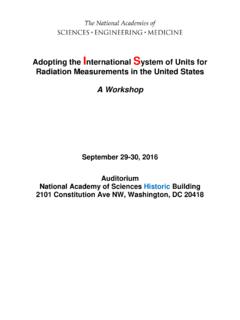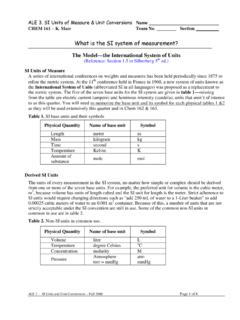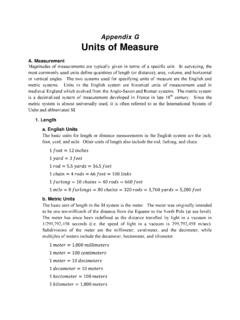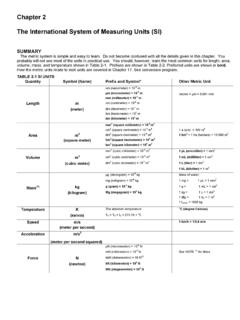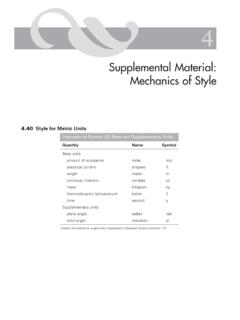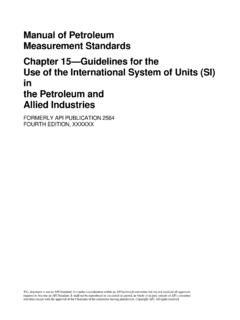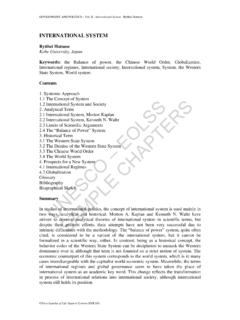Transcription of Chapter 2 Units, Dimensional Analysis, Problem Solving ...
1 Chapter 2 Units, Dimensional analysis , Problem Solving , and Estimation The Speed of light .. 1 international system of Units .. 1 Standard Mass .. 2 Example The international Prototype Kilogram .. 3 Example Mass of a Silicon Crystal .. 4 The Atomic Clock and the Definition of the Second .. 5 The Meter .. 6 Example Light-Year .. 6 Radians and Steradians .. 7 Radiant Intensity .. 9 Dimensions of Commonly Encountered Quantities .. 9 Dimensional analysis .. 11 Example Period of a Pendulum.
2 11 Significant Digits, Scientific Notation, and Rounding .. 12 Significant Digits .. 12 Scientific Notation .. 13 Rounding .. 13 Problem Solving .. 13 General Approach to Problem Solving .. 14 Order of Magnitude Estimates - Fermi Problems .. 16 Methodology for Estimation Problems .. 17 Example Lining Up Pennies .. 17 Example Estimation of Mass of Water on Earth .. 18 2-1 Chapter 2 Units, Dimensional analysis , Problem Solving , and Estimation But we must not forget that all things in the world are connected with one another and depend on one another, and that we ourselves and all our thoughts are also a part of nature.
3 It is utterly beyond our power to measure the changes of things by time. Quite the contrary, time is an abstraction, at which we arrive by means of the change of things; made because we are not restricted to any one definite measure, all being interconnected. A motion is termed uniform in which equal increments of space described correspond to equal increments of space described by some motion with which we form a comparison, as the rotation of the earth. A motion may, with respect to another motion, be uniform.
4 But the question whether a motion is in itself uniform, is senseless. With just as little justice, also, may we speak of an absolute time --- of a time independent of change. This absolute time can be measured by comparison with no motion; it has therefore neither a practical nor a scientific value; and no one is justified in saying that he knows aught about it. It is an idle metaphysical Ernst Mach The Speed of light When we observe and measure phenomena in the world, we try to assign numbers to the physical quantities with as much accuracy as we can possibly obtain from our measuring equipment.
5 For example, we may want to determine the speed of light, which we can calculate by dividing the distance a known ray of light propagates over its travel time, speedoflight=distancetime. ( ) In 1983 the General Conference on Weights and Measures defined the speed of light to be c=299,792,458meters/second. ( ) This number was chosen to correspond to the most accurately measured value of the speed of light and is well within the experimental uncertainty. international system of Units The system of units most commonly used throughout science and technology today is the Syst me international (SI).
6 It consists of seven base quantities and their corresponding base units: 1 E. Mach, The Science of Mechanics, translated by Thomas J. McCormack, Open Court Publishing Company, La Salle, Illinois, 1960, p. 273. 2-2 Base Quantity Base unit Length meter (m) Mass kilogram (kg) Time second (s) Electric Current ampere (A) Temperature kelvin (K) Amount of Substance mole (mol) Luminous Intensity candela (cd) We shall refer to the dimension of the base quantity by the quantity itself, for example dimlength length L,dimmass mass M,dimtime time T.
7 ( ) Mechanics is based on just the first three of these quantities, the MKS or meter-kilogram-second system . An alternative metric system to this, still widely used, is the so-called CGS system (centimeter-gram-second). Standard Mass The unit of mass, the kilogram (kg), remains the only base unit in the international system of Units (SI) that is still defined in terms of a physical artifact, known as the international Prototype of the Standard Kilogram.
8 George Matthey (of Johnson Matthey) made the prototype in 1879 in the form of a cylinder, 39 mm high and 39 mm in diameter, consisting of an alloy of 90 % platinum and 10 % iridium. The international prototype is kept at the Bureau international des Poids et Mesures (BIPM) at Sevres, France under conditions specified by the 1st Conf rence G n rale des Poids et M sures (CGPM) in 1889 when it sanctioned the prototype and declared This prototype shall henceforth be considered to be the unit of mass.
9 It is stored at atmospheric pressure in a specially designed triple bell-jar. The prototype is kept in a vault with six official copies. The 3rd Conf rence G n rale des Poids et Mesures CGPM (1901), in a declaration intended to end the ambiguity in popular usage concerning the word weight confirmed that: The kilogram is the unit of mass; it is equal to the mass of the international prototype of the kilogram. There is a stainless steel one-kilogram standard that can travel for comparisons with standard masses in other laboratories.
10 In practice it is more common to quote a conventional mass value (or weight-in-air, as measured with the effect of buoyancy), than the standard mass. Standard mass is normally only used in specialized measurements wherever suitable copies of the prototype are stored. 2-3 Example The international Prototype Kilogram Determine the type of shape and dimensions of the platinum-iridium prototype kilogram such that it has the smallest surface area for a given volume. The standard kilogram is an alloy of 90 % platinum and 10 % iridium.










